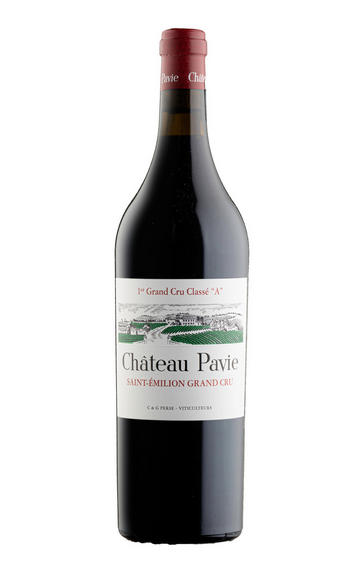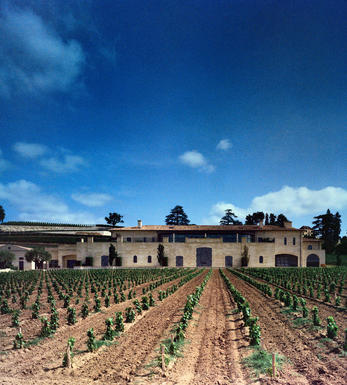
2010 Château Pavie, St Emilion, Bordeaux

Critics reviews
Robert M. Parker, Jr. - 28/08/2015
(Jancis Robinson MW- jancis robinson.com, April 2011)
(James Molesworth – The Wine Spectator – Top Scoring Bordeaux 2010 – 31 Mar 2011)
This great terroir dominates the Cote Pavie, which is a combination of decomposed limestone and more gravelly soils at the bottom of the slope. Kudos to proprietors Chantal and Gerard Perse for continuing to push the envelope of quality and ignoring their jealous critics.
(98+ Robert Parker - Wine Advocate - Feb 2013) Along with several other Medoc first-growths as well as Ausone in St.-Emilion and possibly Petrus and Lafleur in Pomerol, few estates have such a record for consistent quality as Gerard Perse’s Chateau Pavie. Made from a classic blend of 70% Merlot, 20% Cabernet Franc and 10% Cabernet Sauvignon, the 2010 was cropped at a ridiculously low 26 hectoliters per hectare, and the harvest occurred between October 12 and 19. Surprisingly, the alcohol is only 14.2% which is actually less than the 2008 and 2009. Since Perse acquired this estate in 1998, most Pavies have possessed off the charts richness and the 2010 is no different. It also reveals an opaque purple color, abundant notes of roasted coffee, blackberries, cassis, full-bodied power and sensational density, texture and length. There is also a boatload of tannin, so do not expect this 2010 to provide near-term consumption. Somewhat reminiscent of the 2005 in its freshness, precision and intensity, it requires 7-10 years of cellaring and should keep for 3-4 decades thereafter. I had this wine on four separate occasions and would rank it slightly behind the 2000, 2005 and 2009.
(95-98+ Robert Parker- Wine Advocate- May 2011)
About this WINE

Chateau Pavie
Château Pavie is the largest St.Emilion 1er Grand Cru Classé, with over 35 hectares of vineyards located exclusively on the St-Emilion Côtes. Pavie is situated south-east of the village of St-Emilion and its vineyards lie on a south-facing slope of the famous limestone plateau.
Pavie's vineyards are bordered by those of Château La Gaffelière and Château Pavie-Decesse. For many years the property was owned and run by Jean-Paul Valette. In 1998 Gérard Perse, who also owns Pavie-Decesse and Monbousquet, purchased it.
Pavie's wine is typically a blend of 55% Merlot, 25% Cabernet Franc and 20% Cabernet Sauvignon. Since 1998, the grapes have been fermented in spanking new wooden vats with the wine then being aged in 100% new oak bariques for 18 months. It is bottled unfiltered.
Pavie produces elegant, harmonious and stylish St-Emilions that typically display a fine bouquet with good depth of fruit on the palate. Under the Perse regime Pavie has become richer, more intense and more concentrated.

St Émilion
St Émilion is one of Bordeaux's largest producing appellations, producing more wine than Listrac, Moulis, St Estèphe, Pauillac, St Julien and Margaux put together. St Emilion has been producing wine for longer than the Médoc but its lack of accessibility to Bordeaux's port and market-restricted exports to mainland Europe meant the region initially did not enjoy the commercial success that funded the great châteaux of the Left Bank.
St Émilion itself is the prettiest of Bordeaux's wine towns, perched on top of the steep limestone slopes upon which many of the region's finest vineyards are situated. However, more than half of the appellation's vineyards lie on the plain between the town and the Dordogne River on sandy, alluvial soils with a sprinkling of gravel.
Further diversity is added by a small, complex gravel bed to the north-east of the region on the border with Pomerol. Atypically for St Émilion, this allows Cabernet Franc and, to a lesser extent, Cabernet Sauvignon to prosper and defines the personality of the great wines such as Ch. Cheval Blanc.
In the early 1990s there was an explosion of experimentation and evolution, leading to the rise of the garagistes, producers of deeply-concentrated wines made in very small quantities and offered at high prices. The appellation is also surrounded by four satellite appellations, Montagne, Lussac, Puisseguin and St. Georges, which enjoy a family similarity but not the complexity of the best wines.
St Émilion was first officially classified in 1954, and is the most meritocratic classification system in Bordeaux, as it is regularly amended. The most recent revision of the classification was in 2012

Merlot
The most widely planted grape in Bordeaux and a grape that has been on a relentless expansion drive throughout the world in the last decade. Merlot is adaptable to most soils and is relatively simple to cultivate. It is a vigorous naturally high yielding grape that requires savage pruning - over-cropped Merlot-based wines are dilute and bland. It is also vital to pick at optimum ripeness as Merlot can quickly lose its varietal characteristics if harvested overripe.
In St.Emilion and Pomerol it withstands the moist clay rich soils far better than Cabernet grapes, and at it best produces opulently rich, plummy clarets with succulent fruitcake-like nuances. Le Pin, Pétrus and Clinet are examples of hedonistically rich Merlot wines at their very best. It also plays a key supporting role in filling out the middle palate of the Cabernet-dominated wines of the Médoc and Graves.
Merlot is now grown in virtually all wine growing countries and is particularly successful in California, Chile and Northern Italy.


Buying options
Add to wishlist
Description
What fun, excitement and joy it will be to compare the four perfect wines Perse has made in 2005, 2009, 2010 and, of course, the 2000, in 25 or so years. This wine is truly profound Bordeaux. Everything is in place remarkable concentration and a beautiful nose of cedar and ripe blackcurrant and blackberry with some kirsch and spice box in the background. Lavishly rich, with slightly more structure and delineation than the more Rabelaisian 2009, this wine does show some serious tannins in the finish, and comes across as incredibly youthful. Of course, it's five years old, but it tastes more like a just-bottled barrel sample than a 2010. In any event, this wine is set for a long, long life and should be forgotten for at least another decade. Consume it over the following 75 or more years.
Robert M. Parker, Jr. - 28/08/2015
wine at a glance
Delivery and quality guarantee